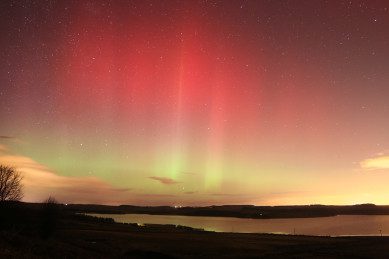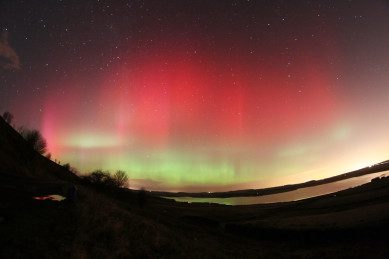Night of the Lights
“Can you see it?” I shout hysterically down the phone to my wife. “See what?” she replies. “The aurora, look out of the bedroom  window and down the street!”. “What am I looking for?” she replies. “A big green arc with lots of red and columns!”.
window and down the street!”. “What am I looking for?” she replies. “A big green arc with lots of red and columns!”.
This is the telephone conversation that took place on the evening of Thursday 27th February. My wife was tucked up at home in the warm in Medomsley, I was standing in a cold, muddy layby near Edmundbyers frantically snapping away with my DSLR as the aurora borealis danced over Derwent reservoir. As an ‘astronomy-widow’ my poor wife is accustomed to being left holding the baby (sometimes literally!) as I skulk off into our back garden or the back of beyond to photograph some faint supernova, gas cloud or planetary conjunction. But Thursday 27th February was something quite special, a once in a decade apparition of the northern lights.
I had spent the early evening (and some of my afternoon at work! Don’t tell the boss!) glued to Aurora forecasting websites and the AUK forum on Facebook. A huge ‘X-class’ flare had errupted on the Sun’s eastern limb, two days earlier, throwing off a wave of charged particles, and there was a chance – maybe just maybe – that wave would sideswipe the earth that evening and trigger a geomagnetic storm and Aurorae. The moon was new, and the weather forecast was for clear skies all night, the conditions could not have been better!
The earth is bombarded by a steady stream of charged particles from the sun all the time, the poetically named ‘solar wind’. This is usually enough to trigger Aurora Borealis in northerly latitudes, such as Lapland and Iceland, but for us poor southerners, we really need a solar storm to enjoy the show.
The Aurora Borealis can be a magical, spiritual experience, but the physics behind it are no less amazing. The earth has a liquid  iron core which generates a magnetic field around the earth. This magnetic field acts as a shield, deflecting harmful charged particles from the Solar Wind that would strip away our atmosphere if left unchecked. However the earth’s magnetic field is such that a small number of particles can flow down into the atmosphere around the poles and where this happens, they crash into our atmosphere where they excite atoms of Oxygen and Nitrogen causing them to emit photons, packets of light, in various colours. It’s the same principle as a fluorescent Neon light but on a massive scale! Green and Red aurorae are usually caused by collisions with Oxygen atoms, while collisions with Nitrogen atoms cause purple and blue aurorae. This all takes place many miles up in the atmosphere, so there is nothing to be scared of!
iron core which generates a magnetic field around the earth. This magnetic field acts as a shield, deflecting harmful charged particles from the Solar Wind that would strip away our atmosphere if left unchecked. However the earth’s magnetic field is such that a small number of particles can flow down into the atmosphere around the poles and where this happens, they crash into our atmosphere where they excite atoms of Oxygen and Nitrogen causing them to emit photons, packets of light, in various colours. It’s the same principle as a fluorescent Neon light but on a massive scale! Green and Red aurorae are usually caused by collisions with Oxygen atoms, while collisions with Nitrogen atoms cause purple and blue aurorae. This all takes place many miles up in the atmosphere, so there is nothing to be scared of!
So it was, when the Auroral warning level on Spaceweather.com had risen to ‘4:Unsettled’ (six is what we really want!), I started to get excited. But, mindful of all the fuel I have wasted over the years chasing meagre auroral displays around the county, I decided I would wait for some more cast-iron evidence before jumping in the car.
Tromso Geophysical Institute’s webpage brings together magnetometer readings from several sites across the arctic. A quick  google over there confirmed there really was definitely something afoot. Then the eyewitness reports started appearing on AUK: “Aurora in Shetland”, “Green in Orkney”, “Activity in Caithness”. Would it get this far south?
google over there confirmed there really was definitely something afoot. Then the eyewitness reports started appearing on AUK: “Aurora in Shetland”, “Green in Orkney”, “Activity in Caithness”. Would it get this far south?
I raced upstairs and looked out of the bedroom window. Our bedroom has a good view over the northern horizon and if there’s any sort of auroral activity, I can usually make out a faint glow over the streetlights. There it was! An arc! To the untrained eye, it could be mistaken for light pollution, but the glow from Newcastle-Gateshead is an amorphous orange mass as seen from Derwentside and this was a clear, off-white curve. After five minutes frantically flapping about, putting on warm clothes and throwing camera gear into the car, I was racing up Burnmill Bank to try and grab a few snaps of the arc before it inevitably faded.
I pulled over at a layby just after Snod’s Edge. This is pretty much where the lighter skies of Consett and Shotley Bridge give way to the majestic dark skies of the North Pennine AONB. I quickly set the camera up on the tripod, and fired off a few 30 second shots. Broad green bands – two of them! Pretty good for 55North, but I could sense things were picking up! So, back in the car and off further west to darker skies beyond Edmundbyers.
Not long after arriving at Pow Hill (about 8pm), all hell broke loose! I had seen one or two interesting displays from the AONB over the last few years, but this was clearly something very special. Colour was visible to the naked eye, not just in long exposures with the camera: the auroral arc was a vivid green and above that was a deep vivid red. Overlaid on that were the shifting white-pink columns, stretching up beyond Polaris into the dark, moonless sky! The whole thing resembled a crown of thorns, and so vivid you felt like you could reach out and touch it.
By 9.45pm, the display had faded somewhat, and appeared to have run its course. My camera’s memory card was full of amazing aurora pictures. I was also feeling pretty frozen by this point so was tempted to call it a night. But the night was still young, and what if things picked up again? I would surely kick myself. So, I jumped back in the car, turned on the heated seats and drove leisurely up to Blanchland Common.
Anyone who has driven over Blanchland Common during the day will know just how fabulous its northern vistas are – on a clear  day you can see all the way to The Cheviots and Scotland beyond. At night, this makes it a perfect location for observing the northern lights. It is also dark – very dark! You can be alone with the universe there. But it is cold too, an overcoat colder than Pow Hill. As I drove up Bale Hill and crested Meadows Edge, I knew the Night of the Lights still had some way to go: I could see a red glow, to the west, over the headlights of my car – this was bright! I dived into the first layby, threw on some extra clothes, then started snapping again. While there wasn’t the same structure I had seen at Pow Hill, the colours were truly vivid here – cyan, green, pink, yellow and especially red!
day you can see all the way to The Cheviots and Scotland beyond. At night, this makes it a perfect location for observing the northern lights. It is also dark – very dark! You can be alone with the universe there. But it is cold too, an overcoat colder than Pow Hill. As I drove up Bale Hill and crested Meadows Edge, I knew the Night of the Lights still had some way to go: I could see a red glow, to the west, over the headlights of my car – this was bright! I dived into the first layby, threw on some extra clothes, then started snapping again. While there wasn’t the same structure I had seen at Pow Hill, the colours were truly vivid here – cyan, green, pink, yellow and especially red!
After that, it really was time to call it a night. It was so cold the sheep were eating the salt off the road and I had work the next day. It later transpired I had missed a third burst of activity from 1:00am, but I was happy to have experienced two thirds of the best auroral display witnessed in this country for many years.
I hope your readers enjoy reading this article and looking at the pictures and are inspired to get out and search for the aurora themselves. Here in Consett We are priveleged to live on the doorstep of some of England’s darkest skies.
This piece was submitted by Dave Thompson of the Durham Astronomical Society. You can find out more about the group on their website which can be found below.
http://www.durhamastronomy.org/






